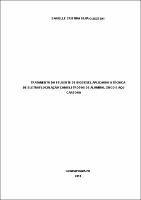| Compartilhamento |


|
Use este identificador para citar ou linkar para este item:
http://tede.unicentro.br:8080/jspui/handle/jspui/1093| Tipo do documento: | Dissertação |
| Título: | TRATAMENTO DO EFLUENTE DE BIODIESEL APLICANDO A TÉCNICA DE ELETROFLOCULAÇÃO COM ELETRODOS DE ALUMÍNIO, ZINCO E AÇO CARBONO |
| Autor: | Oliszeski, Danielle Cristina Silva  |
| Primeiro orientador: | Banczek, Everson do Prado |
| Resumo: | Para atender ao padrão de qualidade exigido pela ANP, o biodiesel necessita ser purificado após sua produção, isto gera alto volume de efluente. No efluente estão presentes ácidos graxos livres, álcool, catalisador e ainda parte oleosa que não reagiu, por isto não pode ser descartado sem antes passar por tratamento, no presente trabalho utilizou-se a técnica de eletrofloculação para tratar o efluente de biodiesel, aplicando um potencial entre eletrodos metálicos para flocular a matéria orgânica, através da estabilização das cargas iônicas. Este trabalho teve como objetivo avaliar a aplicação da técnica de eletrofloculação para o tratamento de efluente de lavagem de biodiesel utilizando eletrodos de alumínio, aço carbono e zinco. Foram realizados ensaios de eletrofloculação em variadas voltagens e tempos para determinar qual a melhor condição em que a técnica ocorresse. O efluente foi analisado antes e após a eletrofloculação por pH, turbidez, demanda bioquímica de oxigênio, demanda química de oxigênio e teor de óleos e graxas (DBO, DQO e TOG, respectivamente). Os eletrodos foram analisados antes e após a eletrofloculação por ensaios de perda de massa, microscopia eletrônica de varredura (MEV) e espectroscopia de energia dispersiva (EDS). Utilizando eletrodo de alumínio no ânodo da célula e ferro no cátodo, obtevese 99% de remoção de óleos e graxas do fluente, o pH assume um valor de 7 e a turbidez reduz 90% se enquadrando na norma regulamentadora. Embora DQO e DBO não reduzam tão significantemente, a eletrofloculação se mostra muito eficiente na remoção de óleos e graxas. Os ensaios de perda de massa, MEV, EDS e mapeamento de superfície indicam a dissolução do alumínio, pois após a eletrofloculação o alumínio apresenta em sua superfície produtos de corrosão. |
| Abstract: | In order to meet the quality standards required by the ANP, biodiesel needs to be purified after its production, this generates a high volume of effluent. In the effluent, free fatty acids, alcohol, catalysts and an unreacted oily part are present, so it can not be discarded without first undergoing treatment, in the present work the electroflocculation technique was used to treat the biodiesel effluent, applying a potential between metallic electrodes to flocculate the organic matter, through the stabilization of the ionic charges. The objective of this work was to evaluate the application of the electroflocculation technique for the treatment of biodiesel washing effluent using aluminum, carbon steel and zinc electrodes. Electroflocculation assays were performed at various voltages and times to determine the best condition in which the technique occurred. The effluent was analyzed before and after the electroflocculation by pH, turbidity, BOD, COD and TOG. The electrodes were analyzed before and after the electroflocculation by mass loss tests, MEV and EDS. Using an aluminum electrode in the anode of the cell and iron at the cathode, 99% removal of oils and grease from the effluent was obtained, the pH assumes a value of 7 and the turbidity reduces 90% if it falls within the norms of the resolutions. Although DQO and DBO do not reduce as significantly, electroflocculation is very efficient in the removal of oils and greases. The tests of mass loss, MEV, EDS and surface mapping indicate the dissolution of the aluminum, since after electrocoleculation the aluminum has on its surface corrosion products. |
| Palavras-chave: | coagulantes cargas iônicas transesterificação coagulants ionic charges transesterification |
| Área(s) do CNPq: | CIENCIAS EXATAS E DA TERRA::QUIMICA ENGENHARIAS CIENCIAS BIOLOGICAS CIENCIAS SOCIAIS APLICADAS::ADMINISTRACAO |
| Idioma: | por |
| País: | Brasil |
| Instituição: | Universidade Estadual do Centro-Oeste |
| Sigla da instituição: | UNICENTRO |
| Departamento: | Unicentro::Departamento de Ciências Agrárias e Ambientais |
| Programa: | Programa de Pós-Graduação em Bioenergia (Mestrado) |
| Citação: | OLISZESKI, Danielle Cristina Silva. TRATAMENTO DO EFLUENTE DE BIODIESEL APLICANDO A TÉCNICA DE ELETROFLOCULAÇÃO COM ELETRODOS DE ALUMÍNIO, ZINCO E AÇO CARBONO. 2018. 47 f. Dissertação (Programa de Pós-Graduação em Bioenergia - Mestrado) - Universidade Estadual do Centro-Oeste, Guarapuava - PR. |
| Tipo de acesso: | Acesso Aberto |
| URI: | http://tede.unicentro.br:8080/jspui/handle/jspui/1093 |
| Data de defesa: | 5-Mar-2018 |
| Aparece nas coleções: | Programa de Pós-Graduação em Bioenergia |
Arquivos associados a este item:
| Arquivo | Descrição | Tamanho | Formato | |
|---|---|---|---|---|
| Dissertação Final - Danielle Cristina Silva.pdf | Danielle Cristina Silva Oliszeski | 1,31 MB | Adobe PDF |  Baixar/Abrir Pré-Visualizar |
Os itens no repositório estão protegidos por copyright, com todos os direitos reservados, salvo quando é indicado o contrário.




